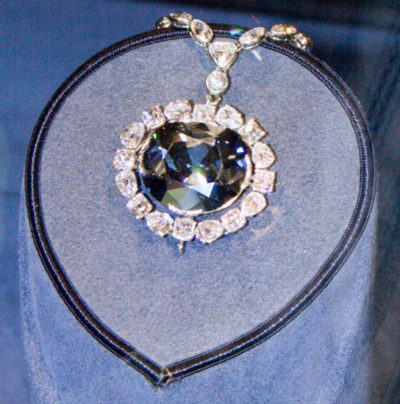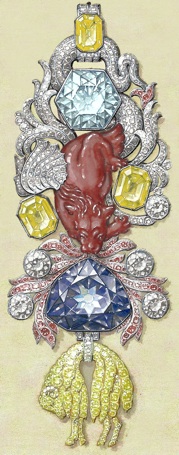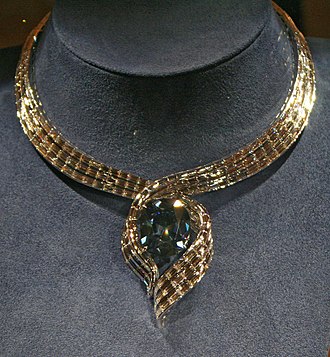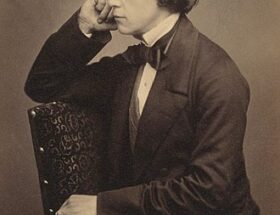
Hope Diamond’s Data
Weight: 45.52 carats
Dimensions: Length 25.60 mm, Width 21.78 mm, Depth 12.00 mm
Cut: Cushion antique brilliant with a faceted girdle and extra facets on the pavilion
Clarity: VS1. Whitish graining is present
Color: Fancy dark grayish-blue
In the pendant surrounding the Hope diamond are 16 white diamonds, both pear-shapes and cushion cuts. The necklace chain contains 45 white diamonds.
Geological Formation
It was formed deep within the Earth approximately 1.1 billion years ago from the formation of strong bonds between the carbon atoms. Originally embedded in kimberlite it was later extracted and refined to form the gem we know today. The rare blue color is a result from trace amounts of boron atoms intermixed with the carbon structure that the diamond contains.
Journey Through the Ages
India
According to Jean-Baptiste Tavernier (a French gem merchant who obtained the diamond in 1666) the gemstone originated in the Kullur mine in the Guntur district of Andhra Pradesh, India. The original owner, place and condition in which the gem was found remains uncertain.
Tavernier brought to Paris a large uncut stone which was the first known precursor to the Hope Diamond and became known as the Tavernier blue diamond. It was a crudely cut triangular shaped stone of 115 carats (23.0 g).
In Six Voyages (Tavernier’s account of his travels) sketches of several large diamonds that he sold to Louis XIV are provided, the blue diamond included.
An unofficial report suggests that in 1669 Tavernier sold this large blue diamond along with approximately one thousand other diamonds to King Louis XIV of France for 220,000 livres, the equivalent of 147 kilograms of pure gold. In a newly published historical novel, The French Blue, gemologist and historian Richard W. Wise proposed that the patent of nobility granted to Tavernier by Louis XIV was also a part of the payment for the Tavernier Blue.
France
In 1678, Louis XIV commissioned the court jeweller Jean Pitau to recut the Tavernier Blue, resulting in a 67.125-carat (13.4250 g) stone listed as the Blue Diamond of the Crown of France by royal inventories.
According to one report, Louis ordered Pitau to “make him a piece to remember”. Pitau took two years on the piece, resulting in a “triangular-shaped 69-carat gem the size of a pigeon’s egg that took the breath away as it snared the light, reflecting it back in bluish-grey rays.” It was set in gold and was supported by a ribbon for the neck which was worn by the king during ceremonies.

In 1749, Louis XIV’s great-grandson, Louis XV, had the French Blue set into a more elaborate jewelled pendant for the Order of the Golden Fleece by court jeweler André Jacquemin. The assembled piece included a red spinel of 107 carats shaped as a dragon breathing fire, as well as 83 red-painted diamonds and 112 yellow-painted diamonds to suggest a fleece shape. The piece fell into disuse after the death of Louis XV. The diamond then became the property of his grandson Louis XIV whose wife, queen Marie Antoinette, used many of the french crown jewels for personal adornment. The French Blue remained in it’s pendant except for a brief time in 1787, when the stone was removed for scientific study by Mathurin Jacques Brisson and returned to its setting soon after.
Theft and Dissappearance
On September 11, 1792, while Louis XVI and his family were imprisoned in the Temple in the early stages of the Reign of Terror during the French Revolution, a group of thieves broke into the Royal Storehouse (now Hôtel de la Marine), and stole most of the Crown Jewels during a five-day looting spree. While many jewels were later recovered (including other pieces of the Order of the Golden Fleece) the French Blue was not among them.
On January 21, 1793, Louis XVI was guillotined while Marie Antoinette was guillotined on October 16 of the same year.
A likely scenario is that the French Blue was smuggled to London after being seized in 1792 in Paris. But the exact rock known as the French Blue was never seen again, since it almost certainly was recut during this decades-long period of anonymity, probably into two pieces, and the larger one became the Hope Diamond. A report suggests that the cut was a “butchered job” because it sheared off 23.5 carats from the larger rock as well as hurting its lustre. It had long been believed that the Hope Diamond had been cut from the French Blue. Confirmation finally happened when a three-dimensional leaden model of the latter was rediscovered in the archives of the National Museum of Natural History in Paris in 2005. Previously, the dimensions of the French Blue had been known only from two drawings made in 1749 and 1789. The leaden model revealed 20 unknown facets on the back of the French Blue. It also confirmed that the diamond underwent a rather rough recut which removed the three points and reduced the thickness by a few millimeters. Historians suggested that one robber, Cadet Guillot, took several jewels, including the French Blue and the Côte-de-Bretagne spinel to Le Havre and then to London, where the French Blue was cut in two pieces.
In a contrasting report, historian Richard Kurin speculated that the theft of the French Crown Jewels was in fact engineered by the revolutionary leader George Danton as part of a plan to bribe an opposing military commander, Duke Karl Wilhelm of Brunswick. When under attack by Napoleon in 1805, Karl Wilhelm may have had the French Blue recut to disguise its identity and, in this form the stone could have come to Britain in 1806, when his family had fled to join his daughter Caroline of Brunswick. Although Caroline was the wife of the Prince Regent George, she lived apart from her husband and financial straits sometimes forced her to quietly sell her own jewels to support her household. Caroline’s nephew, Duke Karl Friedrich, was later known to possess a 13.75-carat (2.750 g) blue diamond which was widely thought to be another piece of the French Blue. This smaller diamond’s present whereabouts are unknown, and the recent CAD reconstruction of the French Blue fits too tightly around the Hope Diamond to allow for the existence of a sister stone of that size.
United Kingdom
A blue diamond with the same shape, size, and color as the Hope Diamond was recorded by John Francillon in the possession of the London diamond merchant Daniel Eliason in September 1812, the earliest point when the history of the Hope Diamond can be definitively fixed, although a second less definitive report claims that the Hope Diamond’s “authentic history” can only be traced back to 1830. The jewel was a massive blue stone of 45.54 carats and weighed 177 grains (4 grains = 1 carat). The 1812 date was just days after 20 years since the theft of the French Blue, just as the statute of limitations for the crime had taken effect.
While the diamond had disappeared for two decades, there were questions whether this diamond now in Great Britain was exactly the same one as had belonged to the French kings, but scientific investigation in 2008 confirmed “beyond reasonable doubt” that the Hope Diamond and that owned by the kings of France were indeed the same gemstone, in the sense that the Hope Diamond had been cut from the French Blue.
There are conflicting reports about what happened to the diamond during these years. Eliason’s diamond may have been acquired by George IV of the United Kingdom possibly through Caroline of Brunswick. There is no record of the ownership in the Royal Archives at Windsor however, although some secondary evidence exists in the form of contemporary writings and artwork, and George IV’s tendancy to mix up the property of the Crown Jewels with family heirlooms and his own personal property.
A Smithsonian source suggested there were “several references” that George had, indeed, owned the diamond. After his death in 1830, it has been alleged that some of this mixed collection was stolen by George’s last mistress, Elizabeth Conyngham, and some of his personal effects were discreetly liquidated to cover the many debts he had left behind him.
Another report states that the king’s debts were “so enormous” that the diamond was probably sold through “private channels”. In either case, the blue diamond was not retained by the British royal family.
The stone was later reported to have been acquired by a rich London banker named Thomas Hope, for either $65,000 or $90,000. It has been suggested that Eliason may have been a “front” for Hope, acting not as a diamond merchant venturing money on his own account, but rather as an agent to acquire the diamond for the banker.
In 1839, the Hope Diamond appeared in a published catalog of the gem collection of Henry Philip Hope, who was a member of the same Anglo-Dutch banking family. The stone was set in a fairly simple medallion surrounded by many smaller white diamonds, which he sometimes lent to Louisa de la Poer Beresford, the widow of his brother, Thomas Hope. After falling into the ownership of the Hope family, the stone came to be known as the “Hope Diamond“.
Henry Philip Hope died in 1839, the same year as the publication of his collection catalog. His three nephews, the sons of Thomas and Louisa, fought in court for ten years over his inheritance, and ultimately the collection was split up. The oldest nephew, Henry Thomas Hope, received eight of the most valuable gems, including the Hope Diamond. It was displayed in the Great Exhibition of London in 1851 and at the 1855 Exposition Universelle in Paris. In 1861, Henry Thomas Hope’s only child, Henrietta, married Henry Pelham-Clinton (later Duke of Newcastle). When Hope died on December 4, 1862, his wife Anne Adele inherited the gem, but she feared that the profligate lifestyle of her son-in-law might cause him to sell the Hope properties.
Upon Adele’s death in 1884, the entire Hope estate, including the Hope Diamond, was entrusted to Henrietta’s younger son, Henry Francis Pelham-Clinton, on the condition that he add the name of “Hope” to his own surnames when he reached the age of legal majority. As Lord Francis Hope, this grandson received his legacy in 1887. However, he had only a life interest in his inheritance, meaning that he could not sell any part of it without court permission.
In 1894, Lord Francis Hope met the American concert hall singer May Yohé and they were married the same year. One account suggests that Yohé wore the Hope Diamond on at least one occasion. She later claimed that she had worn it at social gatherings and had an exact replica made for her performances, but her husband claimed otherwise. Lord Francis lived beyond his means, and this eventually caught up with him, leading to marriage troubles and financial reverses. In 1896 his bankruptcy was discharged but as he could not sell the Hope Diamond without the court’s permission, he was supported financially by his wife during these intervening years. In 1901 the financial situation had changed and after a long legal fight, he was given permission to sell the Hope Diamond by an order of the Master in Chancery to pay off debts. But his wife ran off with a gentleman friend named Putnam Strong.
Francis sold the diamond for £29,000 (£3.09 million today) to Adolph Weil, a London jewel merchant. Weil later sold the stone to the diamond dealer Simon Frankel who took it to New York.
United States
Accounts vary about what happened to the diamond during the years 1902–1907. One account suggested that it lay in the William & Theodore safe during these years while the jewelers took it out periodically to show it to wealthy Americans. Like many jewelry firms, the Frankel business ran into financial difficulties during the depression 0f 1907 and referred to the gem as the “hoodoo diamond.”
In 1908, Frankel sold the diamond for $400,000 ($11.15 million today) to a Selim Habib, a wealthy Turkish diamond collector, reportedly on behalf of Sultan Abdul Hamid of Ottoman Empire. A report, however suggests that the Sultan did own the gem but ordered Habib to sell it when his throne “began to totter”. Habib reportedly sold the stone in Paris in 1909 for $80,000 ($2.23 million today). The Parisian jewel merchant Simon Rosenau bought the Hope Diamond for 400,000 francs and resold it in 1910 to Pierre Cartier for 550,000 francs.
Pierre Cartier tried to sell the Hope Diamond to Washington D.C. socialite Evalyn Walsh McLean and her husband in 1910. He described the gem’s illustrious history to her while keeping it concealed underneath special wrapping paper. The suspense worked: McLean became impatient to the point where she suddenly requested to see the stone. Nevertheless, she initially rejected the offer. Cartier had it reset. She found the stone much more appealing in this new modern style.
The tenuous deal involved wrangling among attorneys for both Cartier and the McLeans but in 1911, the couple bought the gem for over $300,000 (over $8.1 million today).
The gemstone was described as “laying on a bed of white silk and surrounded by many small white diamonds cut pear shaped”. The new setting was the current platinum framework surrounded by a row of sixteen diamonds which alternated between Old Mine Cut and pear-shaped variants. Mrs. McLean wore it to a reception in February 1912 when it was reported that it was the first time it had been worn in public since it had changed owners.
The stone prompted elaborate security precautions: William Schindele, a former Secret Service man, has been engaged to guard the stone. He in turn will be guarded by Leo Costello and Simeon Blake, private detectives. The stone will be kept at the McLean mansion during the day and each night will be deposited in a safe deposit vault. When Mrs. McLean wears the gem at balls and receptions, arrangements have been made to keep the safe deposit building open until after the function that the stone may be safely stored away. A special automobile has been purchased to convey the guards to and from the house to the trust company’s building.
Report in The New York Times, 1911
Fortunately the stone was not stolen during their ownership. When Mrs. McLean died in 1947, she bequeathed the diamond to her grandchildren through a will which insisted that her former property would remain in the custody of trustees until the eldest child had reached 25 years of age. This requirement would have prevented any sale for the next two decades. However, the trustees gained permission to sell her jewels to settle her debts, and in 1949 sold them to New York diamond merchant Harry Winston. Over the next decade, Winston exhibited McLean’s necklace in his “Court of Jewels,” (a tour of jewels around the United States) as well as various promotional events and charity balls. The diamond appeared on the television quiz show The Name’s the Same (the episode first aired on August 16, 1955) when a teenaged contestant with the actual name Hope Diamond was one of the mystery guests, as well as at the August 1958 Canadian National Exhibition. At some point, Winston also had the Hope Diamond’s bottom facet slightly recut to increase its brilliance.
Smithsonian ownership
Smithsonian mineralogist George Switzer is credited with persuading Harry Winston to donate the Hope Diamond for a proposed national gem collection to be housed at the National Museum of Natural History. On November 10, 1958 Winston acquiesced, sending it through U.S. Mail in a box wrapped in brown paper as simple registered mail insured for $1 million at a cost of $145.29, of which $2.44 was for postage and the balance insurance. Upon its arrival it was named Specimen #217868.
Winston had never believed in any of the tales about the curse: his donation of the diamond was with the hope that it would help the United States “establish a gem collection.” Winston died in 1978 of a heart attack. But his gift, according to Smithsonian curator Dr. Jeffrey Post, indeed helped spur additional gifts to the museum.
For its first four decades in the National Museum of Natural History, the Hope Diamond lay in its necklace inside a glass-fronted safe as part of the gems and jewelry gallery, except for a few brief excursions
When the Smithsonian gallery was renovated in 1997, the necklace was moved onto a rotating pedestal inside a cylinder made of 3-inch (76 mm) thick bulletproof glass in its own display room, adjacent to the main exhibit of the National Gem Collection.
In 2005, the Smithsonian published a year-long computer-aided geometry research which officially acknowledged that the Hope Diamond is, in fact, part of the stolen French Blue crown jewel.
In 2009, the Smithsonian announced a temporary new setting for the jewel to celebrate a half-century at the National Museum of Natural History. Starting in September 2009, the 45.52-carat (9.104 g) diamond was exhibited as a stand-alone gem with no setting. It had been removed from its setting for cleaning from time to time, but this was the first time it would be on public display by itself.

On November 18, 2010, the Hope Diamond was unveiled and displayed at the Smithsonian in a temporary newly designed necklace called “Embracing Hope”. The Hope Diamond is also resting on a new dark blue neck form, which the Harry Winston firm commissioned from display organization Pac Team Group.
On January 13, 2012 the diamond was returned to its historic setting and the current necklace was implanted with another diamond worth “at least a million dollars”. The necklace with the new diamond will be sold to benefit the Smithsonian.
The Curse of the Hope Diamond
The diamond has been surrounded by a mythology of a reputed curse to the effect that it brings misfortune and tragedy to persons who own or wear it, although there are strong indications that such stories were fabricated to enhance the stone’s mystery and appeal.
According to various accounts in the late nineteenth and early twentieth century, the original form of the Hope Diamond was stolen from an eye of a sculpted statue of the goddess Sita (the wife of Rama). However, this general type of legend was most likely the invention of Western authors during the Victorian era. It fueled speculation that humans possessing the gemstone were fated to have bad luck with varying reports of undetermined veracity.
The theme of greedy robbers stealing a valuable object from the tomb or shrine of an ancient god or ruler and then being punished by it, is one which repeats in many different forms of literature. A likely source of inspiration for the fabrications was the Wilkie Collins’ 1868 novel The Moonstone, which created a coherent narrative from vague and largely disregarded legends which had been attached to other diamonds such as the Koh-i-Noor and the Orlov diamond. The theme can also be seen in films such as The Mummy as well as stories about the curse of Egyptian king Tutankhamun and in more recent films such as the Indiana Jones films. In keeping with these scripts, according to the legend, Tavernier did not buy the Hope diamond but stole it from a Hindu temple where it had been set as one of two matching eyes of an idol, and the temple priests then laid a curse on whoever might possess the missing stone.
Below is an analytical list with all the owners and wearers of the infamous diamond as well as how they met their end.
| Date acquired | Owner | Fate | Notes |
|---|---|---|---|
| 1653 | Jean-Baptiste Tavernier | Lived 1605–1689 died age 84 | Time of acquisition: between 1640-1667 possibly 1653 |
| 1668 | King Louis XIV | Long prosperous reign; lived 1638–1715 died age 76 | |
| 1722 | King Louis XV | Lived 1710–1774 died age 64 | |
| 1775 | King Louis XVI | Guillotined in 1793, age 38 | |
| 1775 | Marie Antoinette | Guillotined 1793, age 37 | Wife of Louis XVI |
| 1792[12] | Unknown | Stolen | |
| 1805? | King George IV of the United Kingdom | Lived 1762–1830 died age 67 | Doubtful whether he ever owned it |
| 1812 | Daniel Eliason | London jeweler | |
| 1830 | Thomas Hope | Lived 1769–1831 died age 62 | |
| 1839 | Henry Philip Hope | ||
| 1861 | Henry Pelham- Clinton | Lived 1834–1879 died age 45 | |
| 1884 | Lord Francis Hope | bankruptcy; forced to sell it; lived 1866–1941 died age 75 | |
| 1894 | May Yohé | Musical actress, divorced, remarried several times, died poor, age 72 | A wife of Lord Francis Hope |
| 1901 | Adolph Weil | London jewel merchant | |
| 1901 | Simon Frankel | ||
| 1908 | Selim Habib (Salomon? Habib) | Possibly acting as agent for Turkish Sultan Hamid | |
| 1908 | Sultan Abdul Hamid II of Turkey | Deposed 1909; died 1918 age 75 | It is disputed whether the Sultan ever owned it |
| 1909 | Simon Rosenau | ||
| 1910 | Pierre Cartier | Lived 1878–1964, died age 86 | |
| 1911 | Edward Beale McLean and Evalyn Walsh | Couple divorced 1932; Edward had mental illness and died aged 51 or 52; Evalyn died aged 60 from pneumonia in 1947 | |
| 1947 | Harry Winston | Lived 1896–1978 died age 83 | Jeweler who gave it to Smithsonian 1958 |
| 1958 | Smithsonian Institution | Prospered, attendance up |


